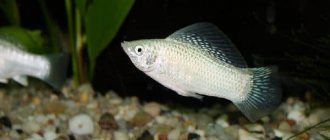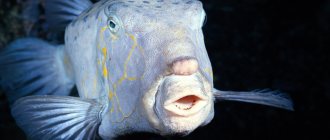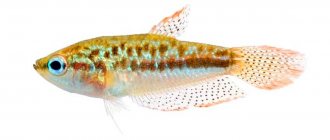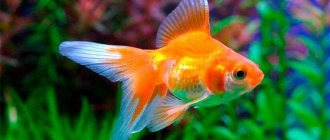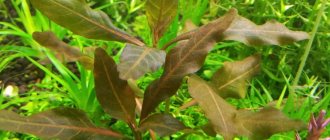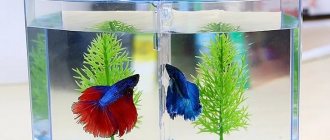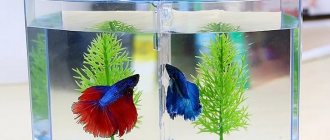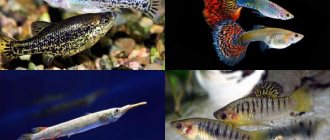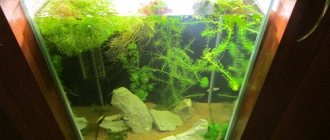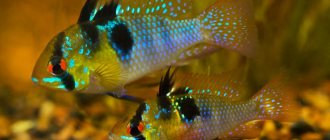What does a gourami look like?
This is a charming fish with an elongated body, slightly compressed from the sides. Its dimensions are small; in aquariums you can rarely find an individual larger than 10 cm; in nature, some species can be 20-25 cm long.
The dorsal and pelvic fins stretch along the entire body, expanding slightly towards the end. The structure of the pectoral fins, which gave the Latin name to the genus - Trichogaster (“thread from the belly”) or Trichopodus (“thread-legged”), is unique: instead of the usual fins, gourami have long thin threads growing in front, which are a tactile organ.
Features of character and lifestyle
Photo: Pearl gourami
Amazing endurance and the presence of a unique respiratory organ make it possible to adapt to almost any water parameters and tolerate the absence of artificial aeration without problems (although other fish of novice aquarists - the same barbs, swordtails and zebrafish - quickly die in the absence of a filter and aerator).
It is worth confirming the unique endurance of gourami with facts. So, these fish can live without problems in a wide range of hardness and acidity levels.
In this case, the most suitable parameters for them will be:
- slightly acidic water (with acidity pH = 6.0-6.8);
- hardness not exceeding 10° dH;
- The water temperature is 25-27°C, and during spawning it requires warmer water, up to 28-30°C.
Moreover, the temperature regime is considered a much more significant parameter, because tropical fish tolerate it very poorly and begin to get sick. Accordingly, in aquariums with gourami, the thermostat is more important than the filter and aerator. In principle, everything corresponds to real living conditions.
A few more important features that are important for artificial living conditions. It is very important to place live algae in the aquarium with gourami, placing them in groups so that there is space for swimming. And one more thing - it is important to ensure the presence of not only algae, but also floating plants (riccia, pistia).
The significance of such plants is that they will soften the bright light, which will enable males to create nests for fry from bubbles (gourami, like an ideal family man, takes care of its offspring). It is important to remember that the plants should not cover the surface of the water 100% - the gourami will emerge from time to time to swallow air.
The most important point when keeping gourami in an aquarium is the presence of cover glasses. With the help of this simple device you can solve 2 problems. Firstly, you will ensure a stable temperature of the air layer on the surface of the water - by swallowing such air, the gouramis will not damage their special respiratory labyrinth, which is sensitive to temperature contrast. Secondly, glass will prevent the death of excessively jumping individuals.
Variety of colors
Varieties of gourami are distinguished by colorful colors and poetic names: marbled gourami, kissing, grumbling, honey, brooding and many others. But if we take a scientifically strict approach, then 4 species directly belong to trichogaster gourami:
- pearl gourami – light silver with a lilac sparkle, strewn with light spots - “pearls”, yellowish back, bluish fins, along the midline the body is divided in half by a dark dotted stripe;
pearl gourami
- moon gourami – about 12 cm long, bluish color with a steely sheen and bright orange eyes, bright, very long orange or yellow breast threads;
- brown gourami – the largest, can reach 15-17 cm, brown-silver, with a stripe along the body in the form of black spots, with transverse stripes of a darker shade than the background;
- spotted gourami – the most colorful, due to crossing, various combinations of yellow, blue and white are possible, spots all over the body of various shapes, transverse and longitudinal stripes are barely visible.
Some color morphs of spotted gourami received their own names - blue, gold and others.
Kinds:
In the scientific classification, six species of Gourami have been identified, but over the long experience of the aquarium industry in keeping and breeding these fish, many new breeding varieties and breeds have emerged. Here are just a few of them.
Kissing
Helostoma temminkii belongs to the Helostomaceae family. This fish is very popular among aquarists because it has an amazing appearance and unusual behavior.
Ichthyologists discovered this natural variety back in the century before last, but breeders from Florida learned to produce offspring of the Kissing Gourami only in the 50s of the last century.
The variety received its name for its expressive large and clearly defined lips. They are strongly protruded and “ready to be kissed.” In addition, two individuals often connect with their mouths. That is, these fish really kiss, maintaining the hierarchy in the school with the help of tactile contacts.
In nature, they are common in Thailand, Indonesia, Sumatra, Borneo, Java, Cambodia, and in any shallow reservoirs with weak currents and rich plant flora.
The natural color is pale greenish-gray. The dimensions are about 15-17 cm. The structure of the lips is also surprising in that on their inner side there are small teeth, with the help of which the fish scrape algae from any surface.
Pink
The full name of this variety of Helostoma temminkii is Pink Kissing Gourami, as it is not a natural species, but bred from the Kissing Gourami.
In these individuals, unlike the progenitor, the body has a more round shape, but its dimensions are smaller, up to 12-13 cm. The color is pinkish or with an orange tint. The structure of the lips is characteristic - they are large and extended forward, as if in readiness for a kiss.
Pink Gourami are hardy and unpretentious to the conditions, but they are still large for the beginning aquarist, since each fish requires about 100 liters of water. And the character of these pets in adulthood becomes not very peaceful, and their breeding is quite problematic.
Blue
Trichopodus trichopterus are inhabitants of South Asian and Indonesian freshwater areas. This variety of Gourami can be found in slow-flowing rivers of Vietnam, China, Cambodia, Laos, Myanmar, Malaysia, Thailand, the Philippines, Taiwan, Papua New Guinea, the Seychelles, Namibia, and Colombia.
The species has many color isomorphs, some of which have been selectively bred.
The body measures 9-15 cm, it is colored whitish-blue with uneven spots. There is also a brown natural variety.
This omnivorous fish is distinguished by the fact that it eats hydra parasites, which are extremely dangerous for the inhabitants of artificial reservoirs.
All variable varieties of Blue Gourami are closely related to wild ancestors, and therefore are distinguished by excellent health. They reproduce well in captivity.
Lyalius
According to the scientific classification, Trichogaster lalius is also a Gourami, as it has labyrinthine breathing and a similar body structure.
This bright, unpretentious fish grows up to 8-9 cm and is suitable even for beginner aquarists.
Initially they were found only in Asian reservoirs, but are now common in America.
The body and fin plumage are colored in multi-colored stripes from greenish to red and orange.
Schooling fish with a clearly defined hierarchical structure. They reproduce well in home aquariums.
Fiery
Gourami or Lyalius of this variety are bred only artificially. They grow up to 7-9 cm, the body is painted in a bright orange fiery color, the plumage on the back is blue.
A bright and unpretentious fish, suitable for beginners.
Gigantic
Osphronemus goramy is the largest representative of Gourami, growing up to 70 cm in its natural habitat, but in an aquarium it reaches only 40 cm.
The species was originally discovered in South Asian slow-flowing water bodies and was used as a commercial fish by the indigenous population; now it is also found in South America and Australia.
The omnivorous large fish even eats frogs and dead mammals.
As they age, males develop a fatty lump on their forehead. The color is light with dark transverse stripes, but with age they fade and the color becomes monochromatic. The pelvic fins, like all Gourami, are thread-like.
In aquarium farming, artificial coloring of fish using chemical injections is widely used, but this significantly reduces the life expectancy of an individual and is condemned in developed countries.
The fish is schooling, but in an aquarium it lives well in a male-female pair. Males often enter into competition with each other, especially when young.
They breed well in captivity, but a large spawning tank is required.
Red-tailed
Osphronemus laticlavius is also a giant species; even in an aquarium, the length of an adult individual reaches 50 cm. Therefore, for home keeping, a tank of 600-700 liters is required, and ichthyologists practically do not try to breed this variety of Gourami in captivity. Sexual dimorphism is almost completely absent and it is impossible to determine the sex, and it is very difficult to populate a flock of at least five specimens.
But this pet has the most colorful colors. The body color is green-blue, and along the edges of the fin plumage there is a fiery border. With age, all scales and fins may turn red.
It lives in slow-flowing rivers of Asia, Malaysia and Indonesia.
Gold
Trichopodus trichopterus is a selective species bred artificially from the Blue Gourami. The pet grows up to 14-15 cm, has a rich golden color, and is unpretentious and easy to breed. Just like the wild ancestor, there may be dark markings on the body.
Honey
Trichogaster chuna is so named because of its bright, rich coloration in yellow and silver-gray tones. Moreover, it is expressive, although different, in representatives of both sexes, but in the male it becomes even more intense during the mating season.
The fish is small, up to 4-5 cm, schooling, very similar to Lyalius. In an artificial reservoir it behaves very timidly and shyly.
The variety is widespread in the Far East. This fish has a very interesting way of feeding. It spits out a stream of water from its mouth, knocking down insects in flight or from branches, shrubs and trees growing near a pond.
Lunar
Trichogaster microlepis are very beautiful, although their color is dull. The small scales are white, almost transparent, but highly reflective. In low light they glow like moonlight.
They live in the reservoirs of Thailand and are called Pla Kadi Nang by the local population. The last word means "female", as this fish was long considered to be the female Blue Gourami. Also found in Vietnam and Cambodia, in the South American Mekong.
With age, the back of the fish acquires greenish tones, and the iris of the eye turns red. The fin plumage of males has the same shades; in females it is pale.
Neon
Trichogaster lalius is an artificial species bred through selective breeding. This is the most famous modification of Lyalius in the aquarium hobby.
The body of small (7-8 cm) fish has a more rounded shape, thread-like pelvic fins are preserved. The main color is a combination of bright multi-colored transverse stripes from turquoise and blue to burgundy shades.
Marble
Trichopodus trichopterus is a breeding variety of Gourami obtained by crossing Blue.
An adult individual grows up to 12-13 cm, has high fin plumage, colored, like the body, in pale blue tones with sparse dark markings and a small scattering of white spots. The color resembles a marble pattern.
Easily reproduce in home aquariums.
Macropods
Macropodus opercularis is also called Paradise fish and is considered one of the most beautiful aquarium pets. These are inhabitants of reservoirs in Southeast Asia with weak currents; their homeland is Thailand, China, Vietnam, Cambodia, Japan, Malaysia, and Taiwan. The species was brought to Europe in the mid-19th century.
They grow in an artificial reservoir up to 10-11 cm. They are distinguished by pointed fin plumage with a large tail. The color is often bluish, with transverse red stripes.
These are omnivorous and hardy fish, behaving quite aggressively in the aquarium. They reproduce easily, but you should watch especially the male during spawning. The male often, protecting the offspring, even beats the female.
Varieties are also known:
- Black Macropod. It lives mostly in Indonesia. It has an almost charcoal body with red fin plumage.
- Round-tailed. This fish grows to only 7-8 cm, its body is also dark, tinged with green, and there may be a red border on the fin plumage. The tail is rounded and very large.
Pearl
Trichopodus leerii is the most peaceful of all Gourami species, growing up to 10-12 cm in length.
They got their name from their original coloring. The main background is light brownish or reddish, with small specks of pearls scattered across it. A patterned border extends along the back to the tail.
The species was discovered in the century before last in Asia. Lives in bodies of water with slow currents in Thailand, Malaysia, Borneo, Sumatra.
The natural population has now greatly decreased, but mass production of fish for the aquarium hobby operates in Europe and the Far East.
They reproduce easily in home tanks.
Platinum
Trichopodus trichopterus is a selected species of Blue Gourami that does not live in natural conditions, although the aquarium variety is unpretentious and hardy.
Pets grow up to 12-13 cm. They are similar to the wild ancestor, but the main background is snowy with a yellowish and silvery tint. The back, belly, and fin plumage are more heavily tinted, with dark markings remaining at the tail and along the midline.
Snakes
Trichopodus pectoralis is a large natural species (15-20 cm) that lives in south-eastern natural reservoirs with weak currents. Distributed in Cambodia, Vietnam, Malaysia, Philippines, Indonesia.
The name is determined by the remarkable color in yellowish and brown tones, patterns reminiscent of snake skin.
Thick lips
Trichogaster labiosa or Labios is a small fish (about 9-10 cm) slightly reminiscent of the Golden Gourami in color.
At first, this species lived only in Asia, but already in the 19th century it was distributed throughout South American waters. The main color is orange or yellowish-brown, males with vertical turquoise stripes. Females are paler and the lines of the pattern are almost invisible.
Peaceful appearance, easy to breed.
Grumpy
Trichopsis vittata - small Gouramis (6-7 cm), living in slow-flowing reservoirs of Vietnam, Laos, Cambodia, Thailand, Malaysia, Indonesia, were also brought to America.
The main background of the body is grayish or brown, there are black longitudinal lines. Males have purple plumage with burgundy markers.
Dwarf
Trichopsis pumila is often called Pumils. This is a small fish (3-4 cm), which is very unpretentious and easily reproduces in captivity.
This variety of Gourami originated from Asia and lives in the rivers of Vietnam and Thailand, Cambodia and Malaysia.
The body is pale brownish with a bluish tint, with two longitudinal black stripes. The plumage is patterned with red and blue dots. It is very difficult to distinguish a male from a female; the male has a slightly brighter color and larger fins.
Thoughtful
Ctenops nobilis or Ctenops are very unpretentious in aquarium keeping and grow up to 9-10 cm.
They live in the Indian rivers Ganges and Brahmaputra, and are also found in Nepal, Bhutan and Bangladesh.
A very warlike appearance with a patterned body in brownish and silvery tones with individual markings. Males are distinguished by red edging on their fins.
Capanuses Dei
Pseudosphromenus dayi is a very calm and peaceful species of Gourami, growing to only 5-6 cm.
In nature, they live in Indian reservoirs, mostly in the foothills of the Western Ghats.
The main background of the body is reddish-brownish, there are longitudinal dark stripes. There is a bluish line along the edge of the fin plumage. Females are paler.
Parosfromenus
This type of Gourami has several varieties. Among them:
- Dark. Parosphromenus nagyi grow to only 3-4 cm, but are very difficult to breed. Endemic to the Malaysian east coast. Males are very bright and warlike. The main background is brownish with two stripes along the entire body. When excited, males turn almost orange and their fin plumage is charcoal with neon bluish markers. Females are much paler.
- Deissner. Parosphromenus deissneri is an endemic species of Bangka Island (Indonesia). Grows up to 4-5 cm. Longitudinal alternating wide stripes of black and yellow colors run along the body. The fin plumage is also colored, but has blue markers. Males become even brighter during spawning. Females are paler.
Labioses
Trichogaster labiosa is a very peaceful variety of Gourami. Natural habitat: Southern Myanmar. In aquarium conditions it grows up to 9-10 cm. Males are slightly larger and brighter colored than females, in blue and orange tones with oblique dark stripes.
Striped
Trichogaster fasciata is also called Coliseum Striped, Lamellar Goura.
They are very simple and unpretentious to keep, easy to reproduce, and suitable for beginner aquarists. They grow up to 8-10 cm and can be kept either in a group or alone.
They are brightly colored in orange and blue colors with stripes and speckles. Females are smaller and paler.
Chocolate
Sphaerichthys osphromenoides grow up to 4-5 cm and are a surprisingly peaceful species of Gourami.
This species has very strong parental instincts, and the main role in breeding offspring in a pair is given to the mother, although usually in labyrinth fish this role is taken by the male.
The homeland of the species is Southeast Asia, Hindustan, Maklaka Peninsula.
The main background of the body is brownish, with transverse stripes of lighter colors located on it. There may be red markers on the plumage (this depends on the habitat of the fish).
False chocolate
Parasphaerichthys lineatus is a very small fish (2 cm), quite pale in color and not very easy to keep and reproduce.
In nature, it mainly lives in slow-moving reservoirs of Myanmar.
The body is quite tall, the male becomes orange in color when excited, and much paler when calm and does not look too much like a true Chocolate Gourami.
Giant chocolate ones
Sphaerichthys acrostoma reach a length of about 7-8 cm in adulthood, their colors are not too bright, and they are not easy to keep.
In nature, they are most found in the rivers of Borneo.
The body is long and narrow, the head is pointed. The background is grayish, the plumage is translucent, the pattern is pale. During spawning, males develop a longitudinal dark stripe.
Belothonia
These fish come in different types. The most common:
- Belothonia Signata. Belontia signata is often called the Sri Lankan Fighting Fish due to its combative nature. Body length reaches 12-13 cm. Endemic species of Sri Lanka. The main background is ruby to ocher in color, the plumage on the tail is uneven and jagged.
- Belothonia Haselda. Belontia hasselti reaches 20 cm in length and has a very unfriendly temper. The homeland of the species is the Greater Sunda Islands, Malaysia, Thailand. The main background of the body is snow-milky with a honeycomb mesh pattern, which becomes very bright during the mating season.
Fish-Crawlers
Anabas testudineus or Anabas, like all labyrinthine species, belongs to the collective name Gourami. The fish is native to Asia, but is now found in both Australian and American waters.
This species is hardy and resilient; it can move on land on pectoral fins and gill covers, using its tail for propulsion.
The coloring of the Pineapple is inconspicuous; in its homeland, the fish is used in fishing.
Individuals grow up to 20-30 cm, with females being larger. The main background is grayish or brownish, there are dark markings, the fins and tail are rounded.
Chameleon Fish
Badis badis are able to change colors and are easy to maintain.
The homeland of the species is Southeast Asia, India, Pakistan, Nepal, Bangladesh, Myanmar, Thailand. They grow up to 5-6 cm, the color is variable - from orange to blue or purple. The color depends on the conditions of the aquatic environment. Males are larger and brighter.
Ctenopomas
Several types of them are known:
- Eight-lane. Microctenopoma fasciolatum is an African variety of Gourami, grows up to 8-9 cm. The main background color is gray or dark brown, it has transverse uneven dark stripes, plumage with a bluish tint.
- Leopard print. Ctenopoma acutirostre also lives in Africa. The color is spotted in brownish tones. The body is high, the fins are jagged. They grow up to 18-20 cm. It is more of a predator, considered conditionally peaceful.
- Sophisticated. Ctenopoma acutirostre is also called Ctenopoma Ansorg. This is a small (6-7 cm) and fairly calm fish, living mostly in the Congo River basin. Males are brighter than females; the pattern consists of transverse wide stripes of gray and orange, which continues on the fin plumage.
Leaf Pisces
Monocirrhus polyacanthus can take the form of leaves that have fallen to the bottom of a reservoir, so they camouflage themselves from predators and while hunting their victims. This is a difficult species to keep and reproduce, distinguished by its interesting appearance and habits.
The homeland of the variety is South America (Brazil, Peru, Venezuela, Colombia, Bolivia).
They grow up to 10 cm. It is better to keep these pets alone or in mixed-sex pairs. The body is narrow, yellowish-brownish, resembling the color of a dried tree leaf. Predators, quite aggressive, feed only on live food during the hunt.
Crestsera paradise fish
Malpulutta kretseri or Malpulutta is named after the Frenchman De Cresset, who was a lawyer, but was passionate about ichthyology.
It is endemic to Sri Lanka and has virtually disappeared from its natural range, but is widely bred in captivity.
Adults grow to only 3-5 cm and are easy to keep and reproduce.
Males are larger and brighter than females. The color is grayish-yellowish speckled with a dark shade. The plumage has a bluish tint and a richer edging.
Ocelathus
Parasphaerichthys ocellatus is also called Ocellated Parasphaerichthys, Dwarf or Burmese Chocolate Goura. A very easy to maintain and reproduce peaceful species, growing only 2-3 cm. They live naturally in Myanmar, throughout the Irrawaddy River basin. They can be kept in an aquarium either singly or in pairs or in a flock.
A related species to the Chocolate Gourami, similar in color but lacking the filiform pelvic fins. The head is large, all plumage is short. In the middle of the body there is a black spot with a golden edge. Females are slightly larger than males, but paler.
Gourami Selatana
Sphaerichthys selatanensis also has another name - Cross Chocolate Gourami. The main background is grayish-brownish, and the pattern is of crosses composed of longitudinal and transverse dark stripes. The body length of adult individuals is about 4-5 cm; in male specimens, unlike females, the lower part of the head is only slightly rounded.
They live in slow-moving ponds of Kalimastan, in the Indonesian province of Selatan, from which they got their name.
Gourami Vaillanta
Sphaerichthys vaillanti is a small fish (4-5 cm) with a peaceful nature and easy to keep. They originate from the western regions of Borneo, but almost the entire natural population has been exterminated.
The body of the fish is high, the head is pointed, the fins on the back and abdomen are long, stretching throughout the body. The color combines red and green colors. Unlike other varieties of Gourami, females become especially bright during the mating season.
Males are pale, grayish-brown, with a pouch of skin under the lower jaw.
Schaller's gourami
Trichopsis Schaller is named after the famous fish exporter Dietrich Schaller, who was the first to bring these individuals to the European market.
Schallers grow up to 4-6 cm, are distinguished by their ability to make peculiar sounds and have a difficult character during the mating season. The rest of the time they behave quite calmly.
In nature, they mostly live in the Mekong River basin in Laos, Thailand, China, Vietnam, and Cambodia.
The color depends on the habitat, it can be blue or yellow. Males are larger and brighter.
How to distinguish a male from a female
It is quite easy to distinguish a boy from a girl gourami: there are several characteristic features.
| Male | Female |
| Larger | Smaller body |
| Slimmer look | Round shape |
| Bright color | Somewhat muted colors |
| The dorsal fin is large and elongated | Dorsal fin small, rounded |
| Pectoral fins orange | Pectoral fins yellow |
| During arousal, the breast changes color and becomes brighter | No changes observed |
Description
— Advertising —
Gourami can be quite large. The length of the fish in the aquarium can be up to 15 cm. The body is flattened on the sides and elongated in length. The lower fin gradually expands from the pectoral to the beginning of the tail. The long upper fin of the male is pointed, while that of the female is rounded and short. The fins on the chest look like long threads that correspond to the size of the body. These whisker-fins have a tactile function.
The body color of gourami is very different. It depends greatly on where you live and can be from greenish-brown to greenish-golden. The general background often has spots or vertical stripes that form mysterious patterns. Possible brindle color with light brown stripes. With good care in a home aquarium, fish can live 7 years.
Maintenance and care
They are unpretentious and tenacious, do not require any special conditions, and are undemanding to the cleanliness and aeration of water. The only thing that is necessary for gourami and without which they can die is access to atmospheric air.
It is advisable that the aquarium have a lid that provides a warm and moist air layer - the labyrinthine organ of the fish is very delicate, it can be injured by temperature differences.
The water in the aquarium should be warm, about 25-27 degrees; cold water is destructive for southern residents. Let there be a lot of aquatic plants, including a couple of thickets where the gourami can hide. Natural driftwood is good for the design and health of fish - they release beneficial humic substances.
When choosing an aquarium, focus on the number of fish and their adult sizes. For a couple of small gouramis, a 20-liter container is also suitable, but for the brown family it is better to take an aquarium of 80-100 liters. You can place several females with one male, but not vice versa - otherwise aggression is possible.
Caring for a gourami’s home is simple:
- do a weekly water change of 20-25% of the total volume;
- occasionally clean the walls of the aquarium;
- From time to time, clean the soil using the siphon method;
- Don’t forget to rinse the internal filter on time.
Features of caring for fry
Proper care of the fry will help increase the survival rate of the offspring. There are several important rules:
- after transplanting the breeders into a common aquarium, lower the water level, provide light aeration and constant heating;
- to ensure the survival of the fry, the water will need to be enriched with oxygen (gourami fry have a peculiarity - the gill labyrinth is not sufficiently developed);
- the water temperature is maintained within + 27… + 29°С;
- remove all large plants, leaving only duckweed floating on the surface (fry can become entangled in algae and die).
Gourami breeding
Even a beginner can handle it. You don’t even have to have a separate container for spawning: a general aquarium is also suitable if it has floating plants and there is no strong current. For reproduction, it is better to slightly increase the water temperature - to 25-27 degrees. A couple of “newlyweds” need to be given plenty of live food for 1-2 weeks.
Gourami have very interesting mating games - males change color and spread their fins. The father builds the nest and takes care of it - he creates a foam ball from air bubbles and his saliva. When finished, he drives the female under the nest and fertilizes the eggs. He will carefully deliver the eggs that float to the top to the nest. After this, the female will want to hide in a shelter, and if this is a separate aquarium, it is better to put her away immediately.
When the larvae hatch, they will spend about 3 more days in the nest, and then, as fry, they will begin to swim, and here it is more advisable to separate the father from them. It practically does not eat during the entire spawning period, so it is better to protect the offspring. It is best to feed the “kids” with ciliates and special food.
After a month, the fry will develop a labyrinthine apparatus.
Diet and nutrition of fry
The young animals do not need to be fed for the first 3–4 days. During this period, they will feed on the contents of the gall sac. Then food is given 5-6 times during the day in small portions so that the fish eat it completely, otherwise the water will become very polluted and will have to be changed too often. .
Simple food is not suitable for feeding small fish. They simply physically cannot grab them with their mouth. The diet is based on live dust.
It is not forbidden to grind tubifex worms into a paste and simply add them to the water. It contains all the valuable substances necessary for proper development and active growth.
As the fry grow older, they are switched to other types of food:
- nauplii;
- ciliates;
- small plankton;
- crustaceans;
- special food for fry.
Periodically give a boiled chicken egg yolk. It is simply crumbled into water.
The diet of the older generation of gourami includes the following food:
- ciliates;
- rotifers;
- liquid food for fry.
The food of young animals should be rich in protein. It helps the scales to develop correctly and makes the color brighter.
Compatibility with other fish
Typically, gourami are peaceful towards other species and live quietly with them in the same aquarium. But aggression is occasionally possible:
- if the size of the aquarium is not enough for comfortable living;
- if there are no or few places for shelter;
- while protecting the nest during spawning.
It has been noticed that gouramis more often fight with relatives or close relatives.
You should not house gourami and swordtails together, as well as Sumatran barbs - they tend to bite the gourami's whiskers. Do not put gourami in an aquarium with cichlids or goldfish.
When should fry be transferred to a community aquarium?
Gourami fry are moved to a common “house” when they are old enough, otherwise older fish will eat them. The maturation period is several weeks.
It will be necessary to relocate in several batches. The effect is due to the fact that some individuals grow faster.
It is important that by the time of relocation the young animals have already begun to eat food intended for adult residents of the community aquarium.
Proper preparation of the producers and arrangement of the spawning ground will help to obtain gourami offspring without any special difficulties. Gourami breed, as a rule, without any problems. There are rarely situations when the female is not yet ready to mate and is constantly hiding from the male. In this case, you need to wait a little.
Where does it live in the wild?
Gourami can adapt to any type of water - standing, flowing, therefore they live both in reservoirs (pond, lake, stakes) and in rivers and streams. Brown and Spotted gouramis easily tolerate salty habitats, which is why they are noticed in the estuaries and tidelands of rivers that flow into seas and oceans.
The homeland is considered to be Malaysia, Vietnam and Thailand, but depending on the type of gourami, the fish are found in the wild in different parts of the world:
- a large number of varieties - Asia from the Southeast side;
- Spotted - from the Malay Archipelago to India;
- Zhemchuzhny – the islands of Borneo and Sumatra;
- Lunar – Cambodia, Thailand.
Many varieties are common in the Antilles, Java, Russia, CIS countries, etc. The reason for this is the release of fish into the wild habitat by aquarists.
Will pearl gourami grow whiskers?
One freshly purchased pearl gourami had half its whisker bitten off (about a year old), I didn’t notice it in the store when I bought it.
Question. Will it grow back, or will my guram always be so “crippled”? It will definitely grow. Only in 2 weeks.
Thank you, otherwise I have such a beautiful, bright red tummy, but my mustache ruins the whole look!
And my gourami has not grown back for two months now. Why?
Crap. It's such a pity! What kind of gourami do you have?
Hotik, it can’t be that the mustache doesn’t grow at all. Most likely, your gourami's whiskers have grown a little. And yours, Khotik, the fish is “healing” so slowly, most likely through no fault of its own. Something is wrong with you.
About six years ago I had gurams, and someone was constantly biting off their whiskers (probably Sumatrans, but I didn’t catch them at the crime scene)
I have marbled gourami. To be honest, from the moment I bought it on the bird, the whiskers haven’t grown at all. As for the conditions, everything seems to be fine: filter, heater, fluorescent lamps, plants. I feed him mostly live food.
Modified 4.4.05 by Khotik
Short whiskers upon purchase may indicate unfavorable conditions when keeping the fish from the previous owner. Not necessarily bitten off. Vitamin deficiency, etc. Mustaches chewed off by enemies usually grow back, but may be shorter than the original ones. In my friend's aquarium, barbs chewed off the guram's whiskers. The mustache has grown back, but is about 1 cm shorter than the second one that was not bitten off.
Feeding
Most Gourami species are omnivorous, only a few of them are carnivorous. But in an aquarium, they do not refuse any, even plant, food.
In nature, labyrinth fish eat:
- larvae;
- adult insects;
- food waste;
- plant organic matter;
- benthic fauna;
- aquatic invertebrates.
In an artificial pond, Gourami enjoy eating:
- bloodworm;
- tubifex;
- daphnia;
- dry and frozen food;
- spirulina tablets;
- scalded and chopped vegetables.
You should not give too large pieces of food, since Gourami’s mouth is small and neat.
Thread carriers are capable of fasting for quite a long time; they can easily endure two weeks without food.
You should also not overfeed these pets; weekly fasting (one day) is beneficial for them.
Diseases
Fish have good immunity, which decreases under unfavorable conditions. Gourami diseases are standard:
- ichthyophthyriosis - infection caused by dirty equipment and decor;
- fin rot – non-compliance with temperature conditions, introduction of sick fish;
- aeromonosis – due to overcrowding;
- hexamitosis is a parasitic infection that requires urgent treatment. It manifests itself in the restlessness of the fish, they experience itching and rub against the surface;
- Ichthyosporidiosis is a parasitic infection;
- lymphocystosis is a mild parasitic infection that does not require treatment;
- ligulosis - due to poor quality food (daphnia).
Treatment is mainly with antibiotics (kostapur, baktopur). After treatment, restoration with good food is required.
Behavior
Calm, peace-loving fish, but this primarily applies to females. Males are not very friendly to each other. During the breeding season or in conditions of lack of space (overcrowding of the aquarium), aggression is possible, and also towards other species. Therefore, the most acceptable option is to keep them in a spacious aquarium in the ratio of one male to several females. It is worth noting that some species, such as Macropods, are extremely warlike and are usually kept alone.
Hybrid gouramis and representatives of other families
If you delve deeper into the gradation and division of gourami subspecies, it becomes clear that this name is quite arbitrary and unites many species of fish from several families, or more precisely, 12 species from five genera. Moreover, researchers identify the genus Helostoma as an independent family.
If you approach the issue scrupulously, you can find out that there is only one gourami - the real one is a commercial fish that reaches 75 cm in length. Residents of the Sunda Islands consider it a rare delicacy. But aquarists are offered a lot of species of “gourami” - dwarf individuals that are not even included in the four main varieties.
Marbled gourami
A mutational subspecies of blue gourami, the representatives of which are quite large in size. Marbled gourami have an oval-shaped body, high, compressed sides, and have characteristic features - thread-like elongated fins and an expanded anal fin.
The main color of the fish is light gray; against this background there are specks of various shapes of dark gray color. The fins, except the pectoral ones, are dark gray in color and covered with yellow spots. The pectoral fins have no color and are transparent. The male has a narrower body, brighter colors and long, pointed dorsal and anal fins.
Golden gourami
The natural habitat of these fish is the ponds of the island of Sumatra with abundant vegetation. The body shape is classic for gourami, the color is golden yellow with an orange tint. There are two dark spots on the side, one in the middle, the other on the tail. There are bluish spots on the main background.
The golden gourami is a peace-loving, timid fish that does not like to get into a fight, but prefers to retreat into the thicket of saving thickets. She is quite accommodating - her neighbors can be both large and small fish. But males of this species are capable of conflicting with each other.
Gourami kissing
These original fish live naturally in Thailand, Kalimantan, Sumatra and Java. They were originally discovered in Indian and Indo-Chinese reservoirs. The fish got their name from the characteristic lip movements that the fish make when they eat, show aggression, and court potential brides/grooms.
The dorsal and anal fins are elongated, of medium height, they are greenish, less often yellowish. The color of kissing gourami is variable; there are gray-green, golden-pink, and yellow individuals. In addition, fish suffering from albinism often appear.
The kissing gourami is a calm, peaceful fish, a little shy. If you place it with non-aggressive brothers, they will get along well in the same aquarium. If the tank turns out to be cramped, they may conflict over territory; they do this funny, opening their mouths. Like other gouramis, these inhabitants need vegetation and various shelters - snags, grottoes, pipes, etc. It is advisable to cover the bottom with dark soil material.
Chocolate gourami
These thread-bearers can be found in Sumatra, Borneo and Malaysia. The fish have a body of a red-brown or chocolate hue, which has a slightly greenish tint. The body has several transverse stripes of varying lengths and widths; their color can vary from light yellow to white. The anal fin is more narrowed, with a yellow border.
Chocolate gouramis are tiny, as they are 4-5 cm long. The male has a straight lower jaw profile, and his head is more pointed than that of the female. The female, due to the fact that she is incubating eggs, has a rounded lower jaw. But there are no differences in color and long fins, like other gouramis, between chocolate females and males.
Gourami grumbling
These fish were so named for their ability to reproduce sounds reminiscent of grunts or frog croaks. Today they have inhabited bodies of water throughout almost the entire territory of Indochina, the Malaysian peninsula and Singapore. These are peaceful underwater inhabitants, cowardly and conflict-free, they are an excellent option for a community aquarium.
Experienced aquarists recommend keeping these fish in a flock of 6-8 pieces; this can be an equal number of males and females, or 1 female for 2 males. Grumpy gouramis like to hide and avoid bright light, so it is advisable to place floating vegetation on the surface that will scatter the rays. In addition, fish plants are used to build nesting sites.
Description, origin and natural range
Gourami includes fish from the families Macropods, Anabass and Helestomidae, which have labyrinthine breathing.
French ichthyologist Pierre Carbonnier chose Gourami as a tropical fish species for acclimatization experiments. For these purposes, fish were caught in their native habitats - reservoirs of Thailand, Vietnam, Malaysia and transported to Europe.
Tropical underwater inhabitants were transported in wooden barrels of water, tightly closed with lids so that when rocking they did not splash out along with the liquid. For a long time, not a single fish could withstand the road, all individuals died. Initially, the scientist could not understand why this was happening, because in nature, Gourami lived well in dirty sewers, but did not survive in a clean, ideal environment. For some period, the world of ichthyology lost interest in these exotic pets.
Gourami photo gallery:
Later, of course, Pierre Carbonnier figured out this problem. The fact is that Gourami, being a representative of the family of Macropods, Anabass and Helestoms, belong to fish with a labyrinthine breathing system. This means that in order to fully exist, they need to often rise to the surface for a breath of clean air. In tightly closed barrels they did not have this opportunity; the oxygen quickly ran out, and all the pets died.
The indigenous population, on the contrary, knew about this feature of Gourami, and when, on their recommendation, the barrels were not completely filled with water and were not sealed tightly, the multi-colored live cargo safely reached Europe.
In 1896, gourami appeared among European aquarists, and a year later - in Russia, they were brought by collectors V. M. Desnitsky and A. M. Meshchersky from Singapore.
The natural habitat of these fish is in the Malay Archipelago, mainly on its largest islands of Sumatra and Kalimantan, in Vietnam, Cambodia, and Thailand. The entire Indo-Malayan zooographic region and Africa are also home to these fish. The biotopes they live in are very diverse - these include stagnant standing water areas and fast-flowing reservoirs, small streams and large rivers, tidal areas and estuaries in which sea and river waters mix.
These fish are often called Threaders because of their long additional ventral fins that really resemble threads.
The organ of additional respiration - the labyrinth - is located in the epibranchial region and is formed in those fish that spend a long time in reservoirs poor in oxygen. These individuals can breathe air and even stay outside the aquatic environment for some time.
The labyrinth is a thin bone plate, penetrated by vessels and covered with a mucous membrane. Gourami begin to breathe air at 2-3 weeks of life and without it they will simply die.
According to some scientific versions, the labyrinth helps Threadbearers to move from one aquatic biotope to another; in this organ they are able to store water reserves that moisturize the gill plates.
Pure oxygen cannot be pumped into the container in which Gourami is transported. Swallowing it, the fish burn their respiratory organs and die.
The size of those species that are most often used in aquarium keeping is 5-13 cm, but there are also large varieties, for example, Serpentine, growing up to 25-30 cm.
Colors, sizes and shapes vary between species, but males are almost always brighter than females, slimmer and larger. However, the expressive color also indicates the health of the individual; in a sick fish it fades.
These tropical fish have a long and tall body, strongly flattened on the sides. Males differ from females in having longer and sharper fin plumage on the back and near the anus; in females it has a rounded shape.
The abdominal filaments are so long that they are approximately equal to the entire length of the body. They have the ability to grow back if they break. These original fins help fish navigate in bodies of water with turbid waters.
All Gourami have a very small and neat mouth.
The Latin name of Gourami Trichogaster is literally translated exactly this way - “having threads on the belly.” And the indigenous population of Indochina and the Malay Archipelago calls all fish that stick their nose out of the water “Gourami”.
Threadbearers are very similar in appearance to Colises; these are fish from a family related to Gourami, which also have threads on their abdomen and breathe air.
These fish usually live in a small family, in which there is a dominant male who actively protects the territory and “his” females. In general, Gourami is a calm and peaceful pet with the correct ratio of males and females.
It is an omnivorous fish, with the exception of some small predatory species. But their main diet in the wild is animal food - insects, larvae and invertebrates. To a lesser extent, they eat plant organic matter, bottom fauna and food waste from other underwater inhabitants. They can easily go for up to 7-14 days without food at all.
Maturity occurs in individuals between 8 and 14 months. The female is capable of giving up to 5 litters (50-2000 larvae) with short intervals between them (about 2 weeks), and then never produces offspring again. Individuals that are more than 14 months old do not participate in reproduction. For laying, the male most often builds a nest from foam.
The lifespan of these labyrinth fish is from 5 to 7 years.
Challenges and opportunities
The fry grow unevenly. Over time, larger and more developed individuals may begin to eat smaller ones. To avoid this situation, you need to start sorting into groups and placing them in different aquariums. If you let the situation take its course, you may lose some of your offspring.
In general, gouramis are tough fish that do well in the aquarium and require more attention early in their life.
What features of fish breeding should be taken into account:
- A pair for spawning should be formed naturally based on observations of growing individuals in the aquarium.
- Young gourami should be bred between the ages of 8 and 12 months. It is important not to miss this period so as not to be left without offspring.
- One of the necessary conditions for spawning is providing the fish with clean water.
- During the spawning period, pregnant females and males need rest. At this time, the spawning tank can be covered with paper or a towel.
- There are cases when individuals begin to spawn without a foam nest. The eggs spread across the water surface, and offspring hatch from them.
The process of breeding gourami at home is not labor-intensive. If you create the necessary conditions for spawning, then in about a month you can get healthy offspring.
Habitat
Habitats in nature are small warm reservoirs, sewers, swamps, poor in oxygen in Southeast Asia: Cambodia, Sumatra, Borneo, Thailand, Vietnam. Such waters are relatively safe: few fish are able to live in water of poor quality. There is enough food there. And the problem of a small amount of oxygen is solved this way: gourami often floats to the surface, swallows a bubble of oxygen and returns to the middle layer. The name "gourami" translates as "fish that sticks its nose out of the water."
